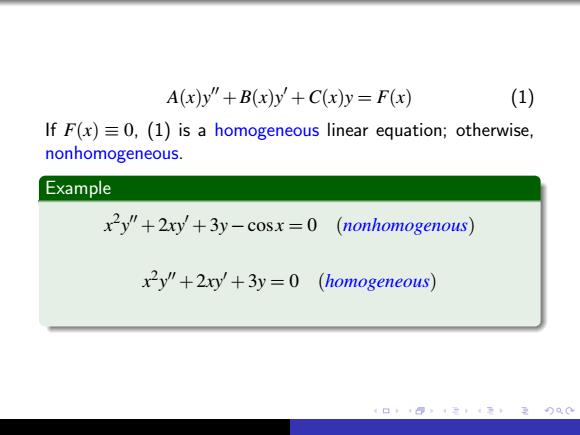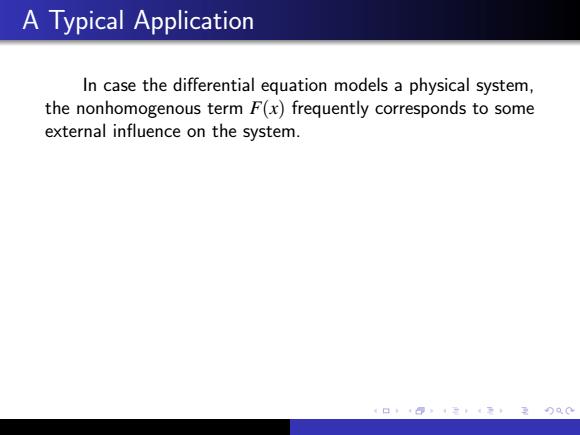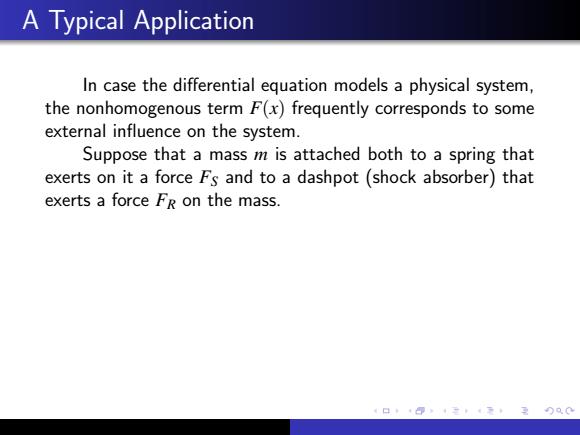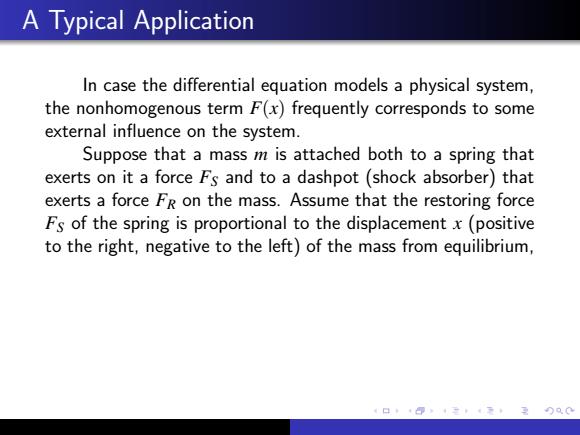
A(x)y"+B(x)y+C(x)y=F(x) (1) If F(x)=0,(1)is a homogeneous linear equation;otherwise, nonhomogeneous. Example x2y"+2xy+3y-cosx=0 (nonhomogenous) x2y"+2y+3y=0 4日10y至,无2000
A(x)y 00 +B(x)y 0 +C(x)y = F(x) (1) If F(x) ≡ 0, (1) is a homogeneous linear equation; otherwise, nonhomogeneous. Example x 2 y 00 +2xy 0 +3y−cos x = 0 (nonhomogenous) x 2 y 00 +2xy 0 +3y = 0 (homogeneous)

A(x)y"+B(x)y+C(x)y=F(x) (1) If F(x)=0,(1)is a homogeneous linear equation;otherwise, nonhomogeneous. Example x2y"+2xy+3y-cosx=0 (nonhomogenous) x2y"+2xy+3y=0 (homogeneous) 4日10y至,无2000
A(x)y 00 +B(x)y 0 +C(x)y = F(x) (1) If F(x) ≡ 0, (1) is a homogeneous linear equation; otherwise, nonhomogeneous. Example x 2 y 00 +2xy 0 +3y−cos x = 0 (nonhomogenous) x 2 y 00 +2xy 0 +3y = 0 (homogeneous)

A Typical Application In case the differential equation models a physical system, the nonhomogenous term F(x)frequently corresponds to some external influence on the system. 4口1日,1元2000
A Typical Application In case the differential equation models a physical system, the nonhomogenous term F(x) frequently corresponds to some external influence on the system. Suppose that a mass m is attached both to a spring that exerts on it a force FS and to a dashpot (shock absorber) that exerts a force FR on the mass. Assume that the restoring force FS of the spring is proportional to the displacement x (positive to the right, negative to the left) of the mass from equilibrium, and that the dashpot force FR is proportional to the velocity v = dx/dt of the mass. Then we have FS = −kx and FR = −cv (k, c > 0)

A Typical Application In case the differential equation models a physical system, the nonhomogenous term F(x)frequently corresponds to some external influence on the system. Suppose that a mass m is attached both to a spring that exerts on it a force Fs and to a dashpot(shock absorber)that exerts a force FR on the mass. 1口1日,元卡20只0
A Typical Application In case the differential equation models a physical system, the nonhomogenous term F(x) frequently corresponds to some external influence on the system. Suppose that a mass m is attached both to a spring that exerts on it a force FS and to a dashpot (shock absorber) that exerts a force FR on the mass. Assume that the restoring force FS of the spring is proportional to the displacement x (positive to the right, negative to the left) of the mass from equilibrium, and that the dashpot force FR is proportional to the velocity v = dx/dt of the mass. Then we have FS = −kx and FR = −cv (k, c > 0)

A Typical Application In case the differential equation models a physical system, the nonhomogenous term F(x)frequently corresponds to some external influence on the system. Suppose that a mass m is attached both to a spring that exerts on it a force Fs and to a dashpot (shock absorber)that exerts a force FR on the mass.Assume that the restoring force Fs of the spring is proportional to the displacement x(positive to the right,negative to the left)of the mass from equilibrium, 4口①,t元2月00
A Typical Application In case the differential equation models a physical system, the nonhomogenous term F(x) frequently corresponds to some external influence on the system. Suppose that a mass m is attached both to a spring that exerts on it a force FS and to a dashpot (shock absorber) that exerts a force FR on the mass. Assume that the restoring force FS of the spring is proportional to the displacement x (positive to the right, negative to the left) of the mass from equilibrium, and that the dashpot force FR is proportional to the velocity v = dx/dt of the mass. Then we have FS = −kx and FR = −cv (k, c > 0)